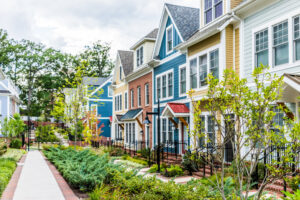
In recent years, a paradigm shift has occurred in the real estate landscape, with a notable trend gaining momentum – the emergence of build-to-rent (BTR) communities. Traditionally, the dream of homeownership has been deeply ingrained in the cultural fabric, but as lifestyles and preferences evolve, the concept of renting has taken on a new and appealing form. This blog explores the flourishing trend of build-to-rent communities and the transformative impact they are having on urban living.
Build-to-rent communities, often referred to as BTR or B2R, represent a departure from the conventional model of individual homeownership or large-scale apartment complexes. In a BTR community, a developer constructs purpose-built rental properties within a planned community, offering residents a unique blend of high-quality living spaces and shared amenities.
Key Features of Build-to-Rent Communities:
- Architectural Innovation: BTR communities are characterized by thoughtful architectural design that maximizes space utilization, energy efficiency, and modern aesthetics. The focus is on creating attractive and functional living spaces that cater to the needs and preferences of today’s urban dwellers.
- Amenities and Shared Spaces: What sets BTR communities apart is the emphasis on communal living. These developments typically include a range of amenities such as fitness centers, coworking spaces, recreational areas, and communal gardens. The aim is to foster a sense of community and provide residents with a lifestyle that extends beyond the confines of their individual homes.
- Flexible Lease Options: BTR communities often offer flexible lease terms, providing residents with the freedom to choose the duration that best suits their lifestyle. This flexibility appeals to a diverse demographic, including young professionals, families, and those who prefer a more transient lifestyle.
- Maintenance and Management: One of the advantages of BTR communities is the hands-on management and maintenance provided by the property developers. Residents can enjoy the perks of a well-maintained community without the responsibilities of homeownership, creating a hassle-free living experience.
- Technology Integration: BTR communities leverage technology to enhance the resident experience. From smart home features to digital communication platforms for community engagement, these communities embrace innovation to create a modern and efficient living environment.
Benefits of Build-to-Rent Communities:
- Affordability and Accessibility: BTR communities often offer a more affordable entry point into desirable urban areas. This affordability, coupled with the flexibility of renting, makes these communities accessible to a wider demographic.
- Community Living: The emphasis on shared amenities and communal spaces fosters a sense of community among residents. BTR communities provide opportunities for social interaction, networking, and a shared sense of belonging.
- Reduced Financial Burden: Residents in BTR communities do not bear the financial responsibilities associated with homeownership, such as property taxes, maintenance costs, and mortgage payments. This allows for greater financial flexibility and freedom.
- Adaptability to Changing Lifestyles: With the option of flexible lease terms, BTR communities accommodate the evolving lifestyles and needs of residents. Whether individuals are looking for a short-term stay or a more long-term commitment, these communities offer the adaptability that modern living demands.
As the demand for housing evolves in tandem with changing societal preferences, build-to-rent communities have emerged as a compelling solution for those seeking a contemporary and community-oriented urban lifestyle. These developments not only redefine the concept of renting but also contribute to the creation of vibrant, sustainable, and accessible urban spaces. The rise of build-to-rent communities marks a transformative era in the way we envision and experience urban living.
